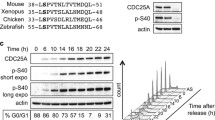Abstract
We report here the cloning and characterization of human and mouse cyclin E2, which define a new subfamily within the vertebrate E-type cyclins, while all previously identified family-members belong to the cyclin E1 subfamily. Cyclin E2/CKD2 and cyclin E/CDK2 complexes phosphorylate histone H1 in vitro with similar specific activities and both are inhibited by p27Kip1. Cyclin E2 mRNA levels in human cells oscillate throughout the cell cycle and peak at the G1/S boundary, in parallel with the cyclin E mRNA. In cells, cyclin E2 is complexed with CDK2, p27 and p21. Like cyclin E, cyclin E2 is an unstable protein in vivo and is stabilized by proteasome inhibitors. Cyclin E2-associated kinase activity rises in late G1 and peaks very close to cyclin E activity. In two malignantly transformed cell lines, cyclin E2 activity is sustained throughout S phase, while cyclin E activity has already declined and cyclin A activity is only beginning to rise. We speculate that cyclin E2 is not simply redundant with cyclin E, but may regulate distinct rate-limiting pathway(s) in G1-S control.
Similar content being viewed by others
Author information
Authors and Affiliations
Rights and permissions
About this article
Cite this article
Lauper, N., Beck, A., Cariou, S. et al. Cyclin E2: a novel CDK2 partner in the late G1 and S phases of the mammalian cell cycle. Oncogene 17, 2637–2643 (1998). https://doi.org/10.1038/sj.onc.1202477
Received:
Revised:
Accepted:
Published:
Issue Date:
DOI: https://doi.org/10.1038/sj.onc.1202477
- Springer Nature Limited
Keywords
This article is cited by
-
Transcribed ultraconserved region 339 promotes carcinogenesis by modulating tumor suppressor microRNAs
Nature Communications (2017)
-
Effects of an 11-nm DMSA-coated iron nanoparticle on the gene expression profile of two human cell lines, THP-1 and HepG2
Journal of Nanobiotechnology (2015)
-
Activation of mitogen- and stress-activated kinase 1 is required for proliferation of breast cancer cells in response to estrogens or progestins
Oncogene (2014)
-
Molecular regulation of stem cell quiescence
Nature Reviews Molecular Cell Biology (2013)
-
Stathmin 1 is a potential novel oncogene in melanoma
Oncogene (2013)




